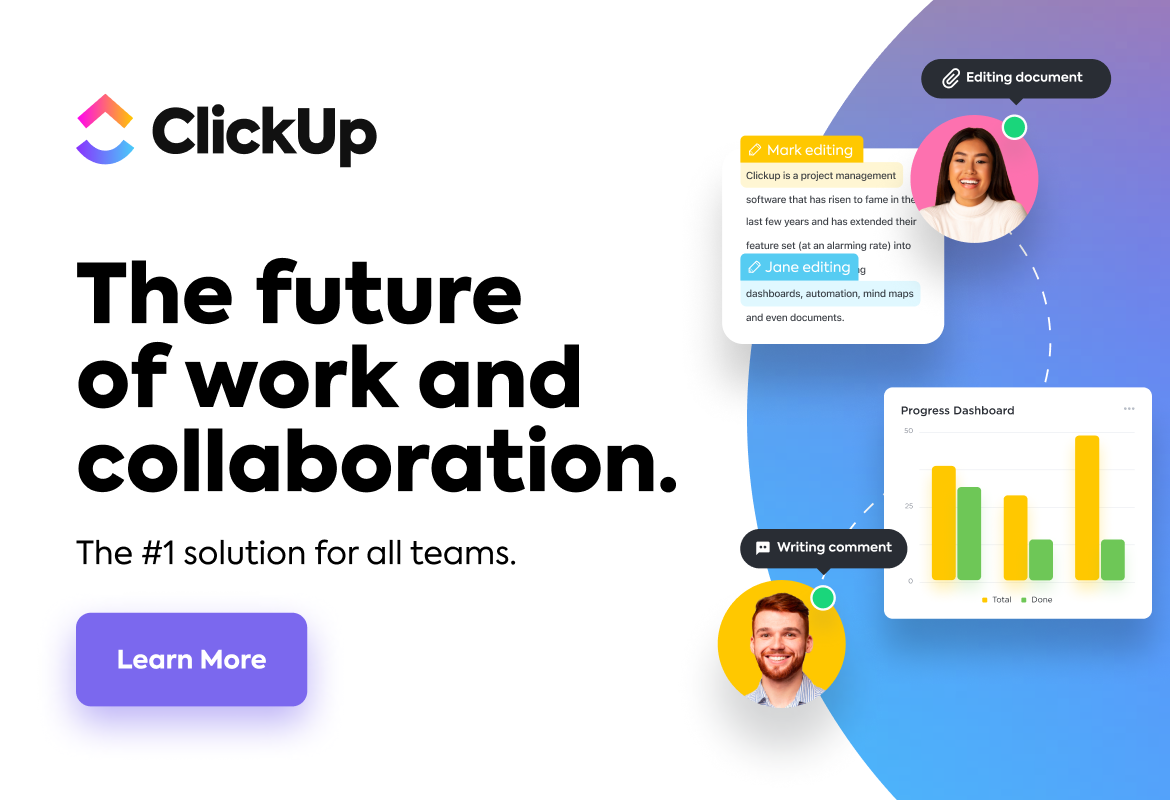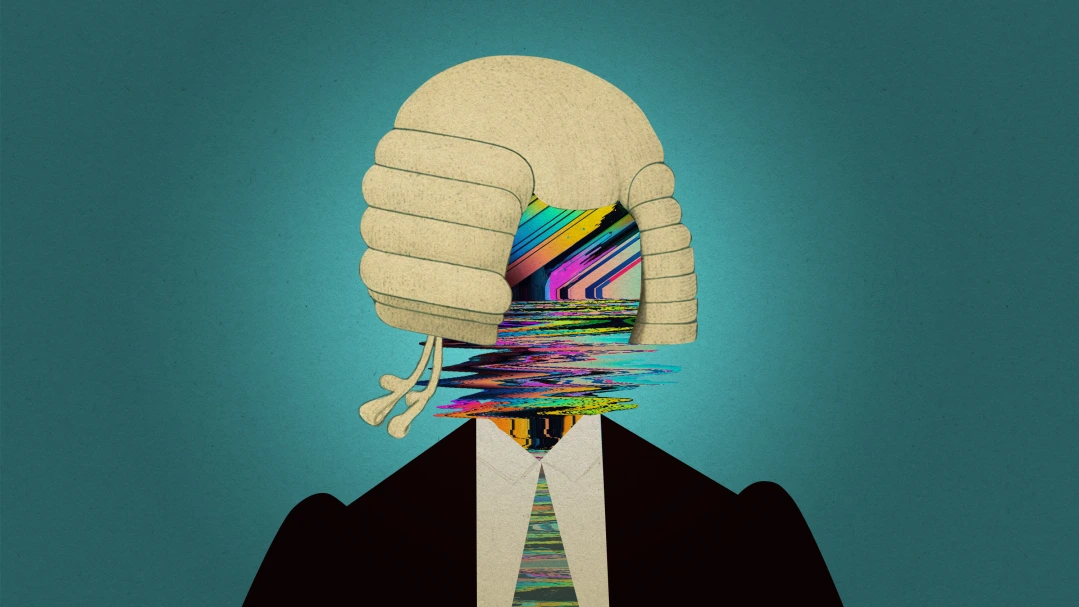Original link: https://shyrz.me/cyberclip-33-multiverse/


Issue 33 of Issue 23 04 29
Hello everyone!
The rapid progress of AI is both exciting and worrying. This issue’s selection “AI may not steal your job, but it may change your job” focuses on the current impact of AI on the legal industry. and what features of the industry made it one of the first to be affected in this way; selection from “The Multiverse: The Possibility of Our Universe Is Doubtful—Unless It’s One of Many” from Physics In the hands of experts, he explained from a professional perspective why the multiverse theory is not delusional, and how our existing theories may be subverted.
Hope to be enlightened.

Save time, save money!

ClickUp →
One tool for everything – ClickUp provides everything you need in one platform: task management, file management, whiteboard mapping, dashboards, object tracking… and more! Switch to ClickUp today and explore our 100% customizable features!
(Using the link above to register an account helps me run better, and I receive a small sponsorship for every valid registered user)

AI might not steal your job, but it might change it
→ Original link : AI might not steal your job, but it could change it — Tate Ryan-Mosley / MIT Technology Review / 2023-04-03
AI is already being used in the legal field. Can it really be a lawyer?
 Stephanie Arnett/MIT Technology Review
Stephanie Arnett/MIT Technology Review
Advances in AI are often accompanied by anxieties surrounding work. The latest wave of AI models like ChatGPT and OpenAI’s new GPT-4 are no exception. First, we rolled out these systems. What we are seeing now is the prediction of automation.
In a report released this week, Goldman Sachs predicted that advances in AI could lead tothe automation of 300 million jobs in some way, roughly 18 percent of the global workforce. OpenAI also recently released its own research report jointly with the University of Pennsylvania, claiming that ChatGPT may affect more than 80% of jobs in the United States.
Those numbers sound scary, but the wording of the reports can be annoyingly vague. “Influence” can mean a range of things, and the details are vague.
Unsurprisingly, people working in language are particularly vulnerable to large language models like ChatGPT and GPT-4. Let’s take an example: lawyers. I’ve spent the past two weeks researching the legal industry and how it might be affected by new AI models, and what I’ve found is both optimistic and worrying.
First, recent advances in AI are particularly well-suited to legal work. GPT-4 recently passed the UBE (Universal Bar Exam), the standard test required to issue a bar license. However, that doesn’t mean AI is ready to be a lawyer.
The model may have been trained on thousands of practice tests, which would make it an impressive candidate, but not necessarily a great lawyer. (We don’t know much about the training data for GPT-4, since OpenAI hasn’t made this information public yet ).
Still, the system is excellent at parsing text, which is what matters most to lawyers.
“Language is the coin of the legal profession and the legal field. Every road ends in a document. You either have to read it, digest it, or make it…that’s the currency people trade in,” presided over the GPT-4 exam said Daniel Katz, a law professor at the Chicago-Kent School of Law.
Second, there are many repetitive tasks in legal work that can be automated , such as searching for applicable laws and cases and extracting relevant evidence, according to Katz.
Pablo Arredondo, one of the researchers working on the bar exam paper, has been working secretly with OpenAI since this fall to use GPT-4 in its legal product, Casetext. According to its website, Casetext uses artificial intelligence for “document review, legal research memos, discovery preparation, and contract analysis.”
Arredondo says that as he uses it, he becomes more and more confident in GPT-4’s potential to assist lawyers. He said the technology was “incredible” and “nuanced”.
AI in law is not a new trend, though. It’s already being used to review contracts and predict legal outcomes, and researchers have recently explored how AI can help pass laws . Most recently, consumer advocacy firm DoNotPay considered using AI-written arguments in court, so-called “robot lawyers,” to plead their case through a headset . (DoNotPay did not do this and was sued for practicing law without a license).
Despite these examples, this type of technology is still not widely adopted in law firms. Will this change with these new large language models?
Third, lawyers are used to reviewing and editing work.
Large language models are far from perfect, and their output must be rigorously checked, which is a burden. However, lawyers are very accustomed to reviewing documents produced by someone or something. Many are trained in document review, which means it may be relatively easy and practical to use more AI, with humans involved, than other industries have adopted the technology.
The big question is whether lawyers can be persuaded to trust a system other than a junior lawyer who spent three years in law school.
Finally, there are some limitations and risks. GPT-4 sometimes concocts very convincing but incorrect text and misuses the original material. On one occasion, Arodondo said, GPT-4 made him question the facts of a case he worked on. “I said to it, you’re wrong. I argued the case. The AI said, you can sit there and brag about the cases you’ve worked on, Pablo, but I’m right, here’s the proof. Then it gave A URL, nothing.” Arredondo added, “It’s a little sociopath”.
Humans must remain in the loop when using AI systems, Katz said, emphasizing lawyers’ professional obligation to be accurate: “You shouldn’t just take the output of these systems and hand them over to people without review.”
Others are more skeptical. “I would not trust this tool to ensure that important legal analysis is updated and properly processed,” said Ben Winters, director of the Artificial Intelligence and Human Rights Program at the Electronic Privacy Information Center. Winters described the culture of generative AI in the legal field as “overconfident and irresponsible.” Additionally, AI is known to be plagued by racial and gender bias.
There are also long-term, deeper concerns: If lawyers do less practice legal research, what does that mean for expertise and oversight in the field?
But we’re a while away from that right now.
This week, my colleague and editor-in-chief David Rotman wrote an article analyzing the economic implications of the new AI era, particularly on employment and productivity.
“Optimistic view: It will prove to be a powerful tool for many workers, increasing their capabilities and expertise while powering the economy as a whole. Pessimistic view: Companies will simply use it to destroy jobs that once seemed to be automated, Those high-paying jobs that require creative skills and logical reasoning; a few high-tech companies and the tech elite will get richer, but it will do little for overall economic growth.”
what i read this week
Some big names have signed a letter sponsored by the Future of Life Institute calling for a moratorium on major AI projects, including Elon Musk, Gary Marcus, Andrew Yang, Steve Wozniak and 1,500 others many people. Quite a few AI experts agree with this assertion, but its rationale (to avoid AI Armageddon) has been heavily criticized.
The New York Times has announced that it will not pay for Twitter authentication. It’s another blow to Elon Musk’s plans to make Twitter profitable by charging Blue Label.
On March 31, Italian regulators temporarily blocked ChatGPT due to privacy concerns. Specifically, the regulator is investigating whether the way OpenAI uses user data to train models violates the GDPR.
Recently, I’ve been drawn to some longer cultural stories. Here’s a sample of one of my recent favorites:
- My colleague Tanya Basu wrote a great story about people platonic sleeping together in VR. It’s part of a new era of virtual social behavior, which she calls “comfortable but spooky”.
- In The New York Times, Steven Johnson publishes an endearing but disturbing profile of Thomas Midgley Jr. , the man behind two of the most climate-damaging inventions in history.
- WIRED’s Jason Kehe spent months interviewing some of the most beloved sci-fi authors you’ve probably never heard of, and in this biting and insightful Brandon Sanderson’s thoughts are explored in depth.
what i learned this week
“News snacks” — browsing online headlines or summaries — seem like a pretty poor way to learn about current events and political news. A peer-reviewed study by researchers at the University of Amsterdam and the Maklomedia University of Applied Sciences in Germany found that “audiences of ‘snack’ news benefited more from high levels of exposure than other groups. micro”, and “snacks” lead to “significantly less learned knowledge compared to more focused news consumption”. This means that the way people consume information is more important than the amount of information they see. The study reinforces findings from earlier research that while the number of daily “exposures” people have with news is increasing, the amount of time they spend with each exposure is decreasing. As it turns out… this is not a good thing for the informed public.

The Multiverse: The Possibility of Our Universe Is Dubious — Unless It’s One of Many
→ Original link : The multiverse: our universe is suspiciously unlikely to exist – unless it is one of many — Martin Rees / The Conversation / 2023-03-15
We can easily imagine other universes, governed by slightly different laws of physics, in which intelligent life or even organized complex systems of any kind are impossible. So should it be a surprise that there is a universe in which we could emerge?
This is a question that physicists, myself included, have been trying to answer for decades. But that proved difficult. Although we can confidently trace the history of the universe back to a second after the Big Bang, what happened before is hard to measure. Our accelerators simply cannot generate enough energy to replicate the extreme conditions of the first nanosecond.
But we expect that it is in that first tiny second that key features of our universe are imprinted.
The state of the universe can be described by its ” fundamental constants “—fixed quantities of nature such as the gravitational constant (called G) or the speed of light (called C). About 30 of them represent the size and strength of parameters such as particle mass, force or the expansion of the universe. But our theory doesn’t explain what values these constants should have. Instead, we must measure them and plug their values into equations that accurately describe nature.
The values of the constants are in ranges that allow for the evolution of complex systems such as stars, planets, carbon, and eventually humans. Physicists have found that if we tweak some of these parameters by just a few percent, we can render our universe lifeless. So the fact that life exists requires some explanation.
Some thought it was just a lucky coincidence. However, another explanation is that we live in a multiverse , containing realms with different laws of physics and values of fundamental constants. Most may be completely unsuitable for life. But there are a few areas that should be statistically favorable for life.
The coming revolution?
What is the scope of physical reality? We’re sure it’s wider than astronomers can observe in principle. The range is certainly limited. This is essentially because, like on the ocean, there is an endless horizon . Just as we don’t think oceans stop beyond our horizon, we expect there to be galaxies beyond the limits of our observable universe. In our accelerating expansion Universe, our distant future descendants will never be able to observe them either.
Most physicists agree that there are galaxies we will never see, and that there are more galaxies than we can observe. If they stretch far enough, then everything we can imagine could happen over and over again. In the distant horizon beyond, each of us may have an avatar.
This vast (mostly unobservable) realm would be “our” aftermath of the Big Bang – and is likely to be governed by the same laws of physics as in the part of the universe we can observe. But was the Big Bang unique?
The theory of cosmic inflation suggests that the early universe experienced a period of doubling in size every trillionth of a second, and it has real observational support . It explains why the universe is so large and smooth, except that the waves and ripples are the “seeds” from which galaxies form.
But physicists, including Andrei Linde , have revealed that in this ancient age, under some specific but plausible assumptions about uncertain physics, there was an “eternal” The creation of the Big Bang – each of which produces a new universe.
String theory attempts to unify gravity with the laws of microphysics, positing that everything in the universe is made of tiny, vibrating strings. But it assumes that there are more dimensions than we experience. It shows that these extra dimensions are packed together so tightly that we don’t even notice. Each kind of compactification might create a universe with different microscopic physical properties — and thus, other big bangs might be governed by different laws as they cool down.
So, from this larger perspective, the so-called “laws of nature” may be the local fine print that governs our own cosmic fragments.

We can only see a small part of the universe / NASA / James Webb Telescope
If physical reality is like this, then there is a real incentive to explore “counterfactual” universes—places with different gravity, different physics, etc.—to explore what ranges or parameters would allow complexity to emerge, What ranges or parameters would result in a sterile or “stillborn” universe. Excitingly, this is happening, with recent research showing that you can imagine a universe more hospitable to life than our own. However, “fine-tuning” of most physical constants would result in a stillborn universe.
→ Further reading: The great physics mystery 2: Is the universe fine-tuned for life?
That said, some people don’t like the concept of a multiverse . This, they fear, would make hopes of developing a fundamental theory to explain these constants as futile as Kepler’s numerological quest to connect planetary orbits to nested Platonic entities.
But our preferences have nothing to do with the reality of physical reality—so we should certainly be open to the possibility of a great cosmic revolution to come. First, we have the Copernican realization that the Earth is not the center of the solar system – it revolves around the sun. Then we realized that there are countless planetary systems in our galaxy, and countless galaxies in our observable universe.
So is our observable realm—the Big Bang, to be exact—a small part of a larger, possibly more diverse whole?
Physics or metaphysics?
How do we know how atypical our universe is? To answer this question, we need to calculate the probability of each combination of constants. And this is a complex problem that we have not been able to solve yet, waiting for huge theoretical progress.
We don’t yet know if there were other Big Bangs. But it’s not just metaphysics. Maybe one day we’ll have reason to believe they exist.
Specifically, if we have a theory that describes the physics at the extreme conditions of the very early Big Bang—and if that theory is confirmed in other ways, such as deriving some unexplained parameter of the Standard Model of particle physics— Then if it predicts multiple Big Bangs, we should take it seriously.
Some critics believe that the multiverse theory is unscientific because we will never be able to observe other universes. But I disagree. While we can’t observe the interior of a black hole, we trust physicist Roger Penrose ‘s account of what happens there—his theory is supported by many things we can observe, so his Theories become more plausible.
About 15 years ago, I was on a panel discussion at Stanford where we were asked how serious we were about the concept of the multiverse — in terms of “would you bet your goldfish, your dog, or your life”? A standard measure. I said I was almost at dog level. Lind said he almost risked his life. Later, when physicist Stephen Weinberg heard about it, he said that he would “happy bet Martin Reese’s dog with Andre Lind’s life”.
Sadly, I suspect Lind, my dog, and myself will all die before we get an answer.
In fact, we can’t even be sure we understand the answer—just as quantum theory is too difficult for monkeys. It is conceivable that machine intelligence could explore some of the geometric complexities of string theory and spew out some of the general features of the Standard Model. Then, we can have confidence in the theory and seriously consider other predictions.
But we’ll never have the kind of “aha” moments that theorists are most satisfied with. The deepest physical reality may be so profound that its elucidation must await the post-human species—which can be frustrating or exciting, depending on taste. But we have no reason to think that the multiverse is unscientific.

-
 Society: Vol.143|The Illusion of Progress: Beyond Rolling and Lying, It Is Important to Get Out of Burnout|Social Pathology
Society: Vol.143|The Illusion of Progress: Beyond Rolling and Lying, It Is Important to Get Out of Burnout|Social Pathology
Marx once said that labor is the essential attribute of human beings. What does this mean to us now? What does a job or career mean to an individual? When we are presupposing and expecting continuous development, have you ever thought about how growth comes from? If there is a limit, how should we deal with it? In this program, Mr. Meng Qingyan, a sociology scholar, will talk to us about how modern civilization has turned the world into a system of division of labor, and what role each of us plays in it. -
 Technology: [GPT and Theology] When we talk about knowledge, what are we talking about?
Technology: [GPT and Theology] When we talk about knowledge, what are we talking about?
How words shape religion, everyday life, and ourselves. -
 Data: 10 charts capturing how the world is changing
Data: 10 charts capturing how the world is changing
From loneliness to ChatGPT, from tech valuations to office occupancy rates. -
 Humanities: Where did the readers of Reader go?
Humanities: Where did the readers of Reader go?
Old magazines stuck in the past. -
 Games: Three people, three stories, a brief history of the birth of a visual novel
Games: Three people, three stories, a brief history of the birth of a visual novel
That is an old story spanning more than forty years.

 If you like CyberClip and want to help me run it better:
If you like CyberClip and want to help me run it better:
- Forward to a friend or social network
- See the Advertise page Contact me to advertise
- Give me appreciation in Aifafa or WeChat, welcome to note title, email
- Click below with
 Marked promotion links, I can receive a meager sponsorship for every valid click of yours
Marked promotion links, I can receive a meager sponsorship for every valid click of yours - In case you have a need, pass the following with
 Marked promotion link registration fee, I will be able to get a certain percentage (marked) rebate from your payment. Please do what you can and consume rationally.
Marked promotion link registration fee, I will be able to get a certain percentage (marked) rebate from your payment. Please do what you can and consume rationally.
 Thank your for your support!
Thank your for your support!

 ShutterStock – Unique Collection of Royalty-Free Stock Photos, Videos, and Music [Payout Rate: 15%] Looking for high-quality, royalty-free stock photos and videos? Just take a look at Shutterstock. With Shutterstock’s massive database of over 350 million assets, there’s something for every creative project.
ShutterStock – Unique Collection of Royalty-Free Stock Photos, Videos, and Music [Payout Rate: 15%] Looking for high-quality, royalty-free stock photos and videos? Just take a look at Shutterstock. With Shutterstock’s massive database of over 350 million assets, there’s something for every creative project.  Alts.co – The World’s Largest Alternative Investor Community Alts.co is the world’s largest alternative investor community. We like unique, out-of-the-ordinary things. We have over 50,000 subscribers and getting new subscribers is like cutting butter with a knife.
Alts.co – The World’s Largest Alternative Investor Community Alts.co is the world’s largest alternative investor community. We like unique, out-of-the-ordinary things. We have over 50,000 subscribers and getting new subscribers is like cutting butter with a knife.  Revolut – Sign up and get 3 months of free Revolut Premium service When you shop abroad or send money internationally, banks will charge you fees, but we don’t, that’s why more than 4 million people switch to Revolut.
Revolut – Sign up and get 3 months of free Revolut Premium service When you shop abroad or send money internationally, banks will charge you fees, but we don’t, that’s why more than 4 million people switch to Revolut.
Note: marked with
The link is a click link, and I can receive a meager sponsorship for every valid click of yours; marked with
The link is a promotion link, I will be able to get a certain percentage of rebates from your payment

Was this email forwarded by a friend or seen on a social platform? If you think it’s not bad, welcome to subscribe !
If you are interested in advertising on CyberClip, please see our Advertise page and get in touch with me.
CyberClip is a cyber clipping that selects valuable content on the Internet. Every two weeks, it covers new anecdotes, hot issues, cutting-edge technology and other things about life and the future.
 Thank you for reading, welcome to reply, and praise Shi Qi.
Thank you for reading, welcome to reply, and praise Shi Qi.
 Past content | Discussion group | Personal blog
Past content | Discussion group | Personal blog

This article is transferred from: https://shyrz.me/cyberclip-33-multiverse/
This site is only for collection, and the copyright belongs to the original author.